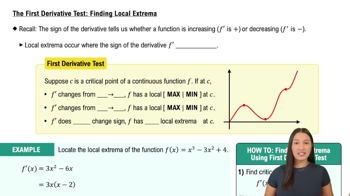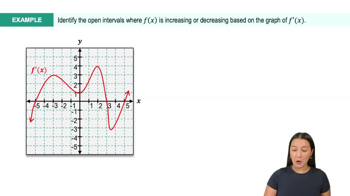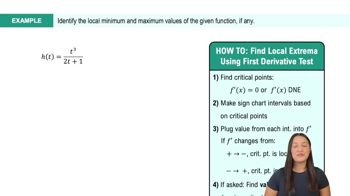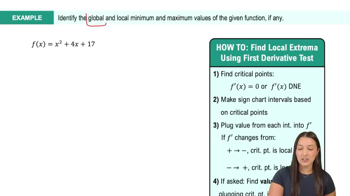Table of contents
- 0. Functions7h 52m
- Introduction to Functions16m
- Piecewise Functions10m
- Properties of Functions9m
- Common Functions1h 8m
- Transformations5m
- Combining Functions27m
- Exponent rules32m
- Exponential Functions28m
- Logarithmic Functions24m
- Properties of Logarithms34m
- Exponential & Logarithmic Equations35m
- Introduction to Trigonometric Functions38m
- Graphs of Trigonometric Functions44m
- Trigonometric Identities47m
- Inverse Trigonometric Functions48m
- 1. Limits and Continuity2h 2m
- 2. Intro to Derivatives1h 33m
- 3. Techniques of Differentiation3h 18m
- 4. Applications of Derivatives2h 38m
- 5. Graphical Applications of Derivatives6h 2m
- 6. Derivatives of Inverse, Exponential, & Logarithmic Functions2h 37m
- 7. Antiderivatives & Indefinite Integrals1h 26m
- 8. Definite Integrals4h 44m
- 9. Graphical Applications of Integrals2h 27m
- 10. Physics Applications of Integrals 2h 22m
5. Graphical Applications of Derivatives
The First Derivative Test
Problem 50
Textbook Question
First Derivative Test
a. Locate the critical points of f.
b. Use the First Derivative Test to locate the local maximum and minimum values.
c. Identify the absolute maximum and minimum values of the function on the given interval (when they exist).
f(x) = 2x⁵ - 5x⁴ - 10x³ + 4 on [-2,4]
 Verified step by step guidance
Verified step by step guidance1
To find the critical points of the function \( f(x) = 2x^5 - 5x^4 - 10x^3 + 4 \), first compute the derivative \( f'(x) \). Use the power rule to differentiate each term: \( f'(x) = 10x^4 - 20x^3 - 30x^2 \).
Set the derivative \( f'(x) \) equal to zero to find the critical points: \( 10x^4 - 20x^3 - 30x^2 = 0 \). Factor the equation to solve for \( x \).
Factor out the greatest common factor: \( 10x^2(x^2 - 2x - 3) = 0 \). Solve \( 10x^2 = 0 \) to find \( x = 0 \). Then solve \( x^2 - 2x - 3 = 0 \) using the quadratic formula or factoring to find additional critical points.
Use the First Derivative Test to determine the nature of each critical point. Evaluate \( f'(x) \) on intervals around each critical point to determine if the function is increasing or decreasing, which will indicate local maxima or minima.
To find the absolute maximum and minimum values on the interval \([-2, 4]\), evaluate \( f(x) \) at the critical points and the endpoints \( x = -2 \) and \( x = 4 \). Compare these values to determine the absolute extrema.
 Verified video answer for a similar problem:
Verified video answer for a similar problem:This video solution was recommended by our tutors as helpful for the problem above
Video duration:
11mPlay a video:
Was this helpful?
Key Concepts
Here are the essential concepts you must grasp in order to answer the question correctly.
Critical Points
Critical points of a function occur where its derivative is zero or undefined. These points are essential for identifying local maxima and minima, as they represent potential locations where the function's behavior changes. To find critical points, one must first compute the derivative of the function and solve for the values of x that satisfy the condition f'(x) = 0.
Recommended video:

Critical Points
First Derivative Test
The First Derivative Test is a method used to determine whether a critical point is a local maximum, local minimum, or neither. By analyzing the sign of the derivative before and after the critical point, one can conclude that if the derivative changes from positive to negative, the point is a local maximum; if it changes from negative to positive, it is a local minimum.
Recommended video:

The First Derivative Test: Finding Local Extrema
Absolute Maximum and Minimum
The absolute maximum and minimum values of a function on a closed interval are the highest and lowest values the function attains within that interval. To find these values, one must evaluate the function at its critical points and at the endpoints of the interval. The largest and smallest of these values will be the absolute maximum and minimum, respectively.
Recommended video:

Finding Extrema Graphically Example 4

 7:32m
7:32mWatch next
Master Determining Where a Function is Increasing & Decreasing with a bite sized video explanation from Callie
Start learningRelated Videos
Related Practice






